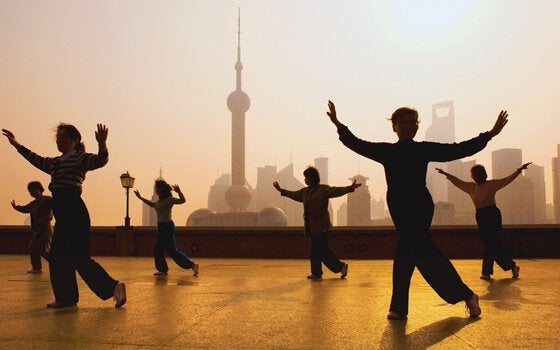Tai Chi or? Taichi has gained great popularity in the world in recent years, this is mainly because it is a martial art that bases its success on the physical and psychic balance it produces, this practice originated in the Chinese Empire, but is currently practiced by thousands of people around the world.
Tai Chi is a physical-spiritual practice, but at the same time a meditation technique, it is an art of struggle, but it is also a lifestyle, it is also known as ‘Meditation on the Move’ and has many followers because there are many who have found great health benefits, both physical and mental, in this meditation.
“Where the water reaches the deepest depth is where it is quietest. “- William Shakespeare-
This martial art consists essentially of learning and practicing sequences of movements or “shapes”. The person must adopt certain postures and then move harmoniously to others, until a sequence is completed. The benefits are many, but among them we can highlight the following.
Tai Chi is closely related to philosophical Taoism, so are we talking about energy?Qi? Or? Chi?. This corresponds to vital energy. According to traditional Chinese medicine, this energy must flow freely through the body and do so in the right way, if this does not happen, discomfort and disease will appear, since Qi is blocked.
Tai Chi’s movements are designed to activate this energy flow and eliminate blockages, this first results in a state of greater well-being of muscles, circulatory system, respiratory system, etc. , in this way strengthens the body in the face of disease.
As mentioned above, Tai Chi is also a relaxation technique. Different postures are designed to relax muscle tension. Similarly, it uses breathing methods that include states of serenity.
Mental balance is one of Tai Chi’s goals. It helps to balance emotions and thus allows a more positive attitude to life to emerge. Commuters are less likely to suffer distress and conflict.
Practically all Tai Chi positions are performed standing, the arms perform movements that range from simple to complex, the joints are the basis of all the practice of this wonderful martial art.
All of these factors combined cause oxygenation and tonicity of the limbs. The arms and legs are very strong. It also prevents muscle loss, which occurs more quickly after age 40.
All exercise practices are excellent for strengthening respiratory and cardiovascular systems, Tai Chi is no exception. However, the fact that it is a fluid and progressive exercise, combining dynamics and pause, is in your favor.
Heart rate has been found to decrease during Tai Chi practice, but circulation increases. Similarly, deep breathing methods increase breathing capacity. Both elements strengthen the body as a whole.
Much of the muscle pain comes from inadequate postures or accumulated tension, Tai Chi postures allow you to adopt better postures daily and relax muscles, reducing these and other pains, such as migraines.
The emphasis on physical and mental balance makes it an ideal practice for people with insomnia, as it allows to channel anxiety so that it does not become an insistent anxiety that prevents rest.
As noted above, in Tai Chi joints play a fundamental role, movements allow mainly to exercise ankles, hips, knees and hands, so the joints become more flexible and strengthened.
Movements require the gradual use of force. They also require a great breadth in the movement of the body, all this helps reduce the risk of falls and injuries, the body acquires a higher level of toning and balance is strengthened.
Tai Chi also appears to strengthen memory because it improves brain oxygenation and increases concentration and acuity, as sequences require both skills to run properly.
It is proven that those with hypertension improve with the practice of Tai Chi. The effects on the cardiovascular system, as well as on the control of emotions, obtained with this martial art make blood pressure not pull and does not stabilize.
As you can see, Tai Chi is a practice with many possibilities, it has no contraindications. It can be practiced at any age and anywhere, it is especially suitable for those who want to enter the world of meditation, but who are looking for something more dynamic than yoga or other methods of relaxation.

